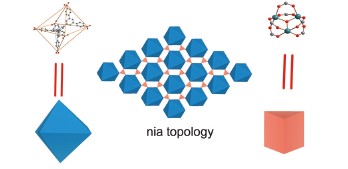| [1] (a) Chae, H. K.; Eddaoudi, M.; Kim, J.; Hauck, S. I.; Hartwig, J. F.; O'Keeffe, M.; Yaghi, O. M. J. Am. Chem. Soc. 2001, 123, 11482; (b) Reinsch, H.; Marszalek, B.; Wack, J.; Senker, J.; Gil, B.; Stock, N. Chem. Commun. 2012, 48, 9486. [2] (a) Tanaka, K.; Muraoka, T.; Hirayama, D.; Ohnish, A. Chem. Commun. 2012, 48, 8577; (b) Zhang, X.-F.; An, X.-H.; Liu, D.-H.; Yang, Q.-Y.; Yang, Z.-H.; Zhong, C.-L.; Lu, X.-H. Acta Chim. Sinica 2011, 69, 84. (张秀芳, 安晓辉, 刘大欢, 阳庆元, 杨祝红, 仲崇立, 陆小华, 化学学报, 2011, 69, 84.); (c) Wu, X.-J.; Yang, X.; Song, J.; Cai, W.-Q. Acta Chim. Sinica 2012, 70, 2518. (吴选军, 杨旭, 宋杰, 蔡卫权, 化学学报, 2012, 70, 2518.) (d) Zhou, Z.-E.; Xue, C.-Y.; Yang, Q.-Y.; Zhong, C.-L. Acta Chim. Sinica 2009, 67, 477. (周子娥, 薛春瑜, 阳庆元, 仲崇立, 化学学报, 2009, 67, 477.)[3] Song, F.; Wang, C.; Falkowski, J. M.; Ma, L.; Lin, W. J. Am. Chem. Soc. 2010, 132, 15390.[4] Chen, B.; Wang, L.; Zapata, F.; Qian, G.; Lobkovsky, E. B. J. Am. Chem. Soc. 2008, 130, 6718.[5] Taylor-Pashow, K. M.; Della Rocca, J.; Xie, Z.; Tran, S.; Lin, W. J. Am. Chem. Soc. 2009, 131, 14261.[6] Tranchemontagne, D. J.; Mendoza-Cortes, J. L.; O'Keeffe, M.; Yaghi, O. M. Chem. Soc. Rev. 2009, 38, 1257.[7] Yaghi, O. M.; O'Keeffe, M.; Ockwig, N. W.; Chae, H. K.; Eddaoudi, M.; Kim, J. Nature 2003, 423, 705.[8] Delgado-Friedrichs, O.; O'Keeffe, M.; Yaghi, O. M. Acta Crystallogr. A 2006, 62, 350.[9] Wang, Z.; Zhang, X.; Batten, S. R.; Kurmoo, M.; Gao, S. Inorg. Chem. 2007, 46, 8439.[10] Chae, H. K.; Eddaoudi, M.; Kim, J.; Hauck, S. I.; Hartwig, J. F.; O'Keeffe, M.; Yaghi, O. M. J. Am. Chem. Soc. 2001, 123, 11482.[11] Bai, Y. L.; Tao, J.; Huang, R. B.; Zheng, L. S.; Zheng, S. L.; Oshida, K.; Einaga, Y. Chem. Commun. 2008, 1753.[12] Jia, J.; Sun, F.; Fang, Q.; Liang, X.; Cai, K.; Bian, Z.; Zhao, H.; Gao, L.; Zhu, G. Chem. Commun. 2011, 47, 9167.[13] Jia, J.; Sun, F.; Borjigin, T.; Ren, H.; Zhang, T.; Bian, Z.; Gao, L.; Zhu, G. Chem. Commun. 2012, 48, 6010.[14] Jia, J.; Lin, X.; Wilson, C.; Blake, A. J.; Champness, N. R.; Hubberstey, P.; Walker, G.; Cussen, E. J.; Schroder, M. Chem. Commun. 2007, 840. |
